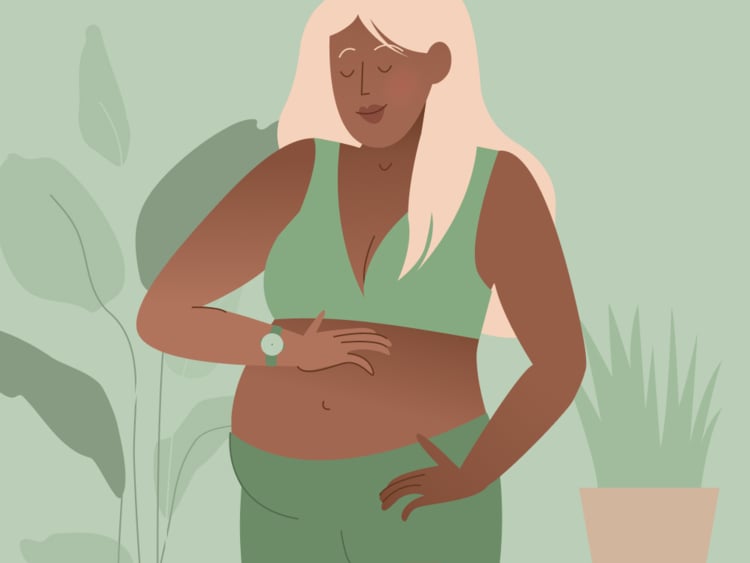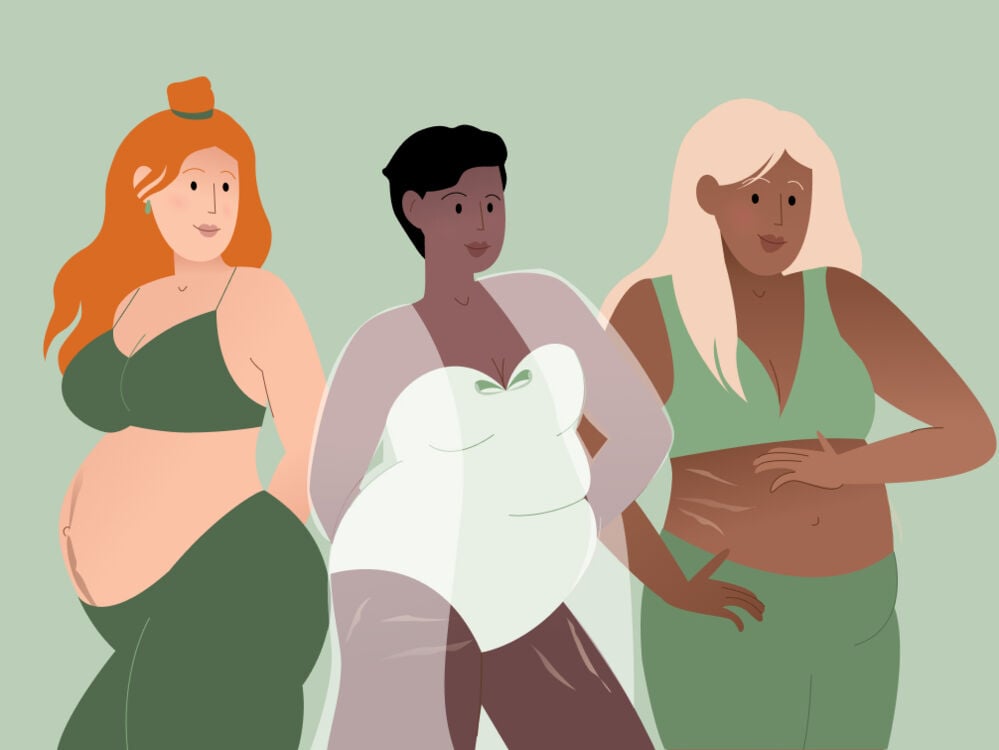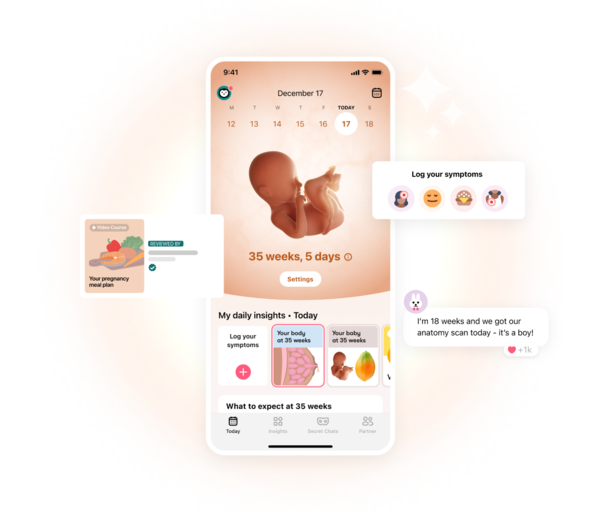Every pregnant belly is different, but what can you expect from your growing baby bump, and how might it change your body?
-
Tracking cycle
-
Getting pregnant
-
Pregnancy
-
Help Center
-
Flo for Partners
-
Anonymous Mode
-
Flo app reviews
-
Flo Premium New
-
Secret Chats New
-
Symptom Checker New
-
Your cycle
-
Health 360°
-
Getting pregnant
-
Pregnancy
-
Being a mom
-
LGBTQ+
-
Quizzes
-
Ovulation calculator
-
hCG calculator
-
Pregnancy test calculator
-
Menstrual cycle calculator
-
Period calculator
-
Implantation calculator
-
Pregnancy weeks to months calculator
-
Pregnancy due date calculator
-
IVF and FET due date calculator
-
Due date calculator by ultrasound
-
Medical Affairs
-
Science & Research
-
Pass It On Project New
-
Privacy Portal
-
Press Center
-
Flo Accuracy
-
Careers
-
Contact Us
Pregnant belly: What to expect from your growing baby bump


Every piece of content at Flo Health adheres to the highest editorial standards for language, style, and medical accuracy. To learn what we do to deliver the best health and lifestyle insights to you, check out our content review principles.
If you’re newly pregnant, it’s natural to wonder when you’ll start to show and what the different pregnant belly stages will look like for you.
But every pregnancy belly will be different, and hopefully, you’ll be glad to know there’s no “normal” size or shape that your growing belly will follow. In fact, to determine how your pregnancy is developing, your health care provider won’t be looking at the shape of your belly. So rest assured that however your bump develops is completely right for you.
Of course, that’s not to say that the whole process has to be a mystery. To find out more about how your pregnancy belly might grow and the changes it can create in your body, we spoke to Dr. Charlsie Celestine, obstetrician and gynecologist, New Jersey, US.
When is a pregnant belly most likely to start showing?
As we know, everyone is different, but you may first start to notice some visible changes to the size of your belly around the 12th week of your pregnancy. “Most likely, the belly will start showing to the point where others would notice it if you wore tight clothing around the middle of the second trimester — around 16 to 20 weeks,” explains Dr. Celestine.
Differences in a growing pregnancy belly: Size and shape
It can be hard not to compare yourself to others when it comes to the shape and size of your pregnant belly, but remember that every baby bump is unique. “Just as bodies vary in shape and size, the pregnant belly is different for each individual,” explains Dr. Celestine.
While your baby will impact the size and shape of your growing uterus, she adds that “There’s no exact science as to why a belly is a certain size. I will say that usually, in early pregnancy, your belly is higher and then drops lower toward the end. But even the high and low levels differ with each person. It’s truly individual.”
Pregnancy is a time of real change for you mentally and physically. You’re adjusting to seeing your body work in new ways and looking different than the way it did before, so the one thing you don’t need to do is be harsh on yourself about how your pregnancy belly is shaping up. Remember Dr. Celestine’s advice that it happens for everyone individually, and try to embrace the changes as and when they come for you.
High pregnant belly and low pregnant belly
As Dr. Celestine explained, having a high pregnant belly is common in the earlier stages of your pregnancy. However, you may notice your pregnant belly ‘drop’ lower into your pelvis as you progress through your third trimester of pregnancy. This process is called engagement (or you might hear it called lightening), and it is your body’s clever way of preparing for labor by moving the baby closer to your pelvis. Wondering when you might go into labor? You can use Flo’s due date calculator to work out your predicted due date.
What changes might your pregnant belly cause for your body?
As your baby bump grows, you may notice a number of physical symptoms like stretch marks or back pain. Not everyone experiences these changes, however, so if you haven’t got these symptoms, then don’t worry; it doesn’t mean anything is wrong.
Stretch marks
Stretch marks are indented streaks on the skin that can appear on the belly during pregnancy. “Stretch marks can happen at any time, but it’s most common to see them late into the second trimester and into the third trimester as the skin really starts to stretch,” explains Dr. Celestine. “Stretch marks have two underlying causes. Firstly, they have a genetic link. If your mom or sister had them during pregnancy, then you are likely to as well. Secondly, they truly do come from skin stretching. So if your skin stretches quickly, they tend to appear.”
Dr. Celestine continues: “The best things you can do (which are not 100% guaranteed to work) are to not gain over the recommended amount of weight in pregnancy and also keep the skin hydrated with oils and lotions.” Of course, you can also rely on drinking good old-fashioned water for hydration.
Weight gain during pregnancy varies greatly for different women, and a healthy weight gain will depend on your own weight before pregnancy. As with everything pregnancy-related, weight gain is unique to everyone. Try not to get carried away with fixating on how much you’re gaining; some weight gain in pregnancy is absolutely normal. Remember to eat a healthy, varied diet, try to remain active if you can, and most importantly, don’t be hard on yourself about the way your body is changing.
Belly button
You may be surprised to hear that your pregnant belly expansion can also change the appearance of your belly button. “For some people, the pregnant belly button remains the same, whereas for others, it pops out,” says Dr. Celestine. “This means an ‘innie’ becomes an ‘outie’ temporarily.”
Experts say this is most likely to happen in the second or third trimester, and it most commonly occurs when you’re around 26 weeks pregnant. While the change might be alarming, rest assured that this is completely normal, and there’s no need to worry. “[The belly button] usually reverts back to normal in the few weeks after delivery,” adds Dr. Celestine.
A line on pregnant belly (linea nigra)
Around 80% of pregnant people will get a linea nigra — a dark vertical line through the center of your belly, sometimes extending all the way from the abdomen to the pubic bone. It usually appears during the second trimester.
“This line appears due to the hormone changes in pregnancy,” says Dr. Charlsie Celestine. “If you have darker skin, you tend to have a darker line. This will also disappear in the weeks after delivering your baby.” Ever wondered if there’s such a thing as a “baby girl belly” vs a “baby boy belly”? As you can imagine, there are plenty of unfounded old wives’ tales on it, and one of them links to the linea nigra. “There’s a myth that the length of the line indicates the gender of your baby, but that’s not true — it’s all just hormones.”
Experts aren’t entirely sure what the linea nigra is for or the exact hormone that causes it. However, some believe it’s due to the rising levels of the melanocyte-stimulating hormone created by the placenta. This causes a rise in melanin, the substance that gives your skin its color.

Back pain
There’s no getting around it: unfortunately, your growing belly can also cause back pain. Rest assured; this is common — in fact, studies show that between 50% and 80% of pregnant women experience back pain, so you’re certainly not alone in your pain. Thankfully, there are various things you can do to relieve it, from having a massage to taking a warm bath.
But why do so many pregnant people experience back pain? “Back pain in pregnancy has two causes,” explains Dr. Celestine. “The hormone changes in pregnancy cause the tendons and cartilage that hold your spine and joints in their proper position to soften. This can cause pain and can happen as early as the first trimester. Also, as your uterus grows, it shifts your center of gravity, meaning that your posture changes and can put stress on your lower back. This type of back pain usually happens at the end of the second to the third trimester.”
Difficulty breathing
It’s completely understandable that feeling breathless during pregnancy can be very worrying. While you shouldn’t ignore this symptom, it’s unlikely to be a sign that anything is wrong. Research suggests that around 60% to 70% of healthy pregnant women experience shortness of breath during pregnancy, so you’re certainly in good company.
“If you have difficulty breathing, you should always have this evaluated by your doctor first,” says Dr. Celestine. “But it’s also common in the third trimester. The uterus and baby are up so high that for some people, it limits their ability to take a normal deep breath.”
How to take care of your pregnant belly
During your pregnancy, it might feel soothing to moisturize your bump. Planning a self-care evening for yourself? You’ll find plenty of beauty products targeting these pregnancy symptoms, including pregnancy belly masks that work similarly to a traditional face mask.
How might a pregnant belly change during each trimester?
As we’ve seen, your belly will continue to grow through each trimester, often sitting higher up at the start and dropping lower to the pelvis by the end of your pregnancy.
If you’re carrying more than one baby, your baby bump might also appear to be growing faster. “It’s the same [as carrying one baby], just larger, and you’ll feel or see symptoms and signs such as back pain and belly button changes sooner,” explains Dr. Celestine.
First-trimester pregnant belly: Weeks 1 to 12
During your first trimester, you may not see any visible signs of a baby bump. Instead, you may experience other early signs of pregnancy, like nausea or constipation.
You may also feel and look bloated, which can be confusing when you’re looking for signs of an early pregnancy belly. However, bloating in early pregnancy is usually caused by rising levels of progesterone — not by the size of the baby. The hormone makes the muscles in your womb relax, preparing it to expand along with your growing baby.
Second-trimester pregnant belly: Weeks 12 to 27
Your baby will continue to grow rapidly throughout the second trimester. It’s perhaps no surprise then that this is the trimester when you will most likely start to show or see your belly expand — especially if you’re having more than one baby or carrying your second child.
Third-trimester pregnant belly: Weeks 28 to 40
Around week 31, in your third trimester, your baby will have finished most of their major development and will start to gain weight rapidly. Your bump will continue to grow, and your stomach might feel tight. This can feel uncomfortable, but hang in there; it won’t be long until you can meet your new baby.
Take a quiz
Find out what you can do with our Health Assistant
Post-pregnancy belly: What happens to your belly after delivery?
As you experience the changes happening to your body during the months of pregnancy, it’s completely natural to wonder what will happen after giving birth. Dr. Celestine explains what you can expect: “After delivery, the uterus slowly starts to shrink back to its normal size in your pelvis. As that happens, the skin and abdominal muscles also start to go back into position.”
How quickly this will happen varies hugely from person to person. “It can take weeks to months,” adds Dr. Celestine. Try not to set any expectations for yourself, and remember everything your body has just achieved!
Looking for some idea of what you might expect? As one Flo user said in our Secret Chats: “After delivery, our bodies, bellies, and boobs can seem huge compared to how we were. You are wonderful no matter whether you snap back right away or whether it takes 12 months!”
Another Flo user added: “It’s nearly three weeks since I gave birth. My stomach has horrendous stretch marks! Got lots of loose skin still, and my belly button is still nonexistent. The best thing of all, though, is I have a beautiful and healthy baby girl.”
Meanwhile, another user said: “It took a whole nine months for this belly to grow — it definitely won’t take a day to go back. It’s a process, and I’m ready to wait.”
Pregnant belly: The takeaway
Remember that the size, shape, and symptoms of your belly expansion vary hugely from person to person. Your second trimester (which you can track using a pregnancy app like Flo) is when you’ll most likely start to see physical changes to your belly. These will continue through to the end of your pregnancy. It’s also the trimester when you might first spot stretch marks, a linea nigra, and changes to your belly button.
But whether you feel like you have a huge pregnant belly or a barely visible bump, every pregnant belly is beautiful. So try to relax and embrace your unique bump however and whenever it grows.


Hey, I'm Anique
I started using Flo app to track my period and ovulation because we wanted to have a baby.


The Flo app helped me learn about my body and spot ovulation signs during our conception journey.


I vividly
remember the day
that we switched
Flo into
Pregnancy Mode — it was
such a special
moment.
Real stories, real results
Learn how the Flo app became an amazing cheerleader for us on our conception journey.
References
“Fetal Development: The 3rd Trimester” Mayo Clinic, 3 June 2022, www.mayoclinic.org/healthy-lifestyle/pregnancy-week-by-week/in-depth/fetal-development/art-20045997.
“Fundal Height.” Cleveland Clinic, my.clevelandclinic.org/health/diagnostics/22294-fundal-height. Accessed 7 Dec. 2022.
Goland, Sorel, et al. “Shortness of Breath during Pregnancy: Could a Cardiac Factor Be Involved?” Clinical Cardiology, vol. 38, no. 10, Oct. 2015, pp. 598–603.
“How Your Baby Develops Week to Week.” NHS Inform, www.nhsinform.scot/ready-steady-baby/pregnancy/your-baby-s-development/how-your-baby-develops-week-to-week. Accessed 7 Dec. 2022.
“Hydrated Skin: Does Drinking Water Help?” Mayo Clinic, 21 Nov. 2020, www.mayoclinic.org/healthy-lifestyle/adult-health/expert-answers/hydrated-skin/faq-20058067.
James, Karmon. “Why Do Belly Buttons Pop During Pregnancy?” Cleveland Clinic, 12 Mar. 2019, health.clevelandclinic.org/why-do-some-womens-belly-buttons-pop-out-during-pregnancy/.
“Linea Nigra.” Cleveland Clinic, my.clevelandclinic.org/health/body/23488-linea-nigra. Accessed 7 Dec. 2022.
“1st Trimester Pregnancy: What to Expect.” Mayo Clinic, 8 Mar. 2022, www.mayoclinic.org/healthy-lifestyle/pregnancy-week-by-week/in-depth/pregnancy/art-20047208.
Sabino, Jennifer, and Jonathan N. Grauer. “Pregnancy and Low Back Pain.” Current Reviews in Musculoskeletal Medicine, vol. 1, no. 2, June 2008, pp. 137–41.
“Back Pain in Pregnancy.” NHS, www.nhs.uk/pregnancy/related-conditions/common-symptoms/back-pain/. Accessed 7 Dec. 2022.
“Week-by-Week Guide to Pregnancy.” NHS, www.nhs.uk/start4life/pregnancy/week-by-week/1st-trimester/week-10/. Accessed 7 Dec. 2022.
“Week-by-Week Guide to Pregnancy.” NHS, www.nhs.uk/start4life/pregnancy/week-by-week/3rd-trimester/week-34/. Accessed 7 Dec. 2022.
“Weight Gain in Pregnancy.” NHS, www.nhs.uk/pregnancy/related-conditions/common-symptoms/weight-gain/. Accessed 7 Dec. 2022.
“Your Baby in the Birth Canal.” MedlinePlus, medlineplus.gov/ency/article/002060.htm. Accessed 23 Dec. 2022.
History of updates
Current version (16 January 2023)
Published (12 August 2019)
In this article

Get your personal guide to pregnancy with the Flo app
-
Follow your baby's growth week by week
-
Get expert info on symptoms, safe foods, and more
-
Chat with other parents-to-be




